Evaluation of High-Volume Injections Using a Modified Dorsal Quadratus Lumborum Block Approach in Canine Cadavers
- PMID: 35011124
- PMCID: PMC8749509
- DOI: 10.3390/ani12010018
Evaluation of High-Volume Injections Using a Modified Dorsal Quadratus Lumborum Block Approach in Canine Cadavers
Abstract
The quadratus lumborum (QL) block targets the fascial plane surrounding the QL muscle providing abdominal somatic and visceral analgesia. The extension of its analgesic effects is a subject of research, as it could not cover areas of the cranial abdomen in dogs. This study assesses in eight thawed canine cadavers, the distribution of high-volume injections (0.6 mL kg-1 of a mixture of methylene blue and iopromide) injected between the psoas minor muscle and the vertebral body of L1. Anatomical features of the area of interest were studied in two cadavers. In another six dogs, QL blocks were performed bilaterally under ultrasound-guidance. The distribution of contrast was evaluated by computed tomography (CT). Hypaxial abdominal muscles were dissected to visualize the dye spread (spinal nerves and sympathetic trunk) in 5 cadavers. The remaining cadaver was refrozen and cross-sectioned. CT studies showed a maximum distribution of contrast from T10 to L7. The methylene blue stained T13 (10%), L1 (100%), L2 (100%), L3 (100%), L4 (60%) and the sympathetic trunk T10 (10%), T11 (20%), T12 (30%), T13 (70%), L1 (80%), L2 (80%), L3 (60%) and L4 (30%). These findings may suggest that despite the high volume of injectate administered, this modified QL block could not produce somatic analgesia of the cranial abdomen, although it could provide visceral analgesia in dogs.
Keywords: abdominal analgesia; canine; locoregional anesthesia; ultrasound.
Conflict of interest statement
The authors declare no conflict of interest.
Figures
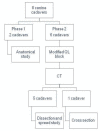

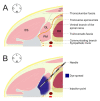


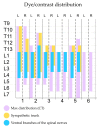
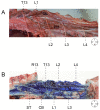

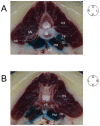
References
LinkOut - more resources
Full Text Sources
Research Materials

